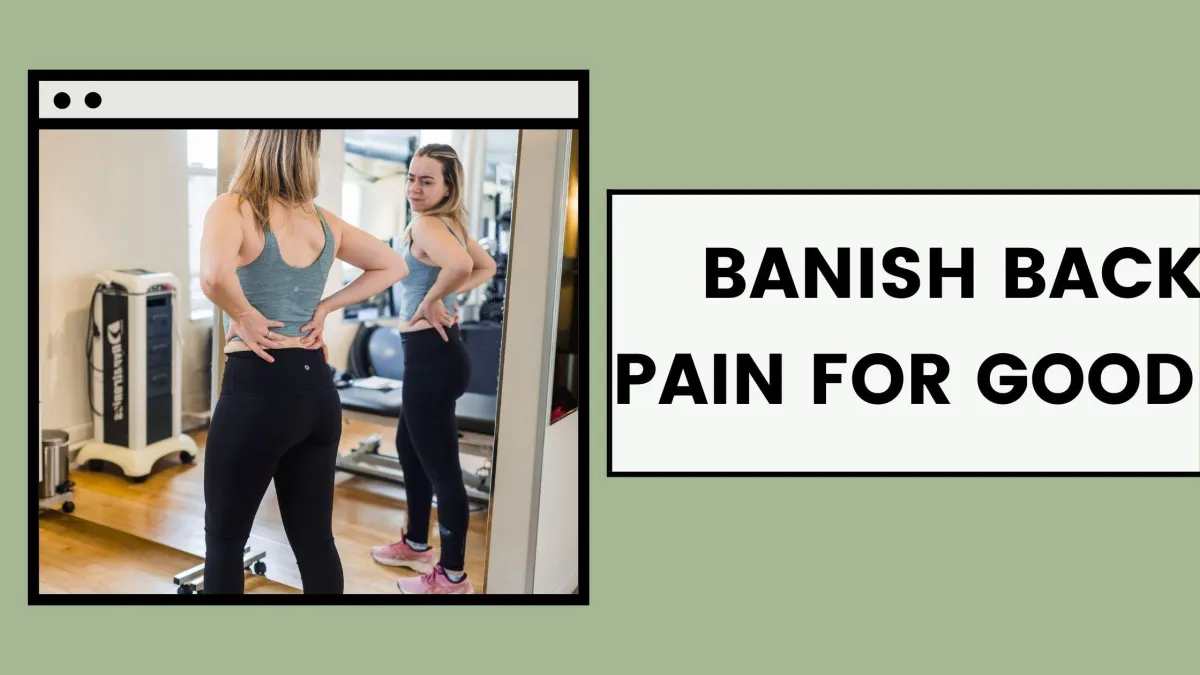Check Out The Latest Blog Posts To Learn More

Banish Back Pain for Good
Banish Back Pain for Good with These Expert Tips
Back pain can be an unwelcome companion in your daily life. Whether you're an office worker, a senior, a fitness enthusiast, a busy mom, or someone who suffers from chronic back pain, finding relief can feel like an uphill battle. But there’s good news. By making a few adjustments and adopting some practical strategies, you can significantly reduce or even eliminate back pain.
In this blog post, we’ll explore five essential tips to help you deal with back pain effectively. From ergonomic adjustments to targeted exercises, we’ve got you covered. Read on, and take the first step toward a pain-free life.
Understanding Back Pain
What Causes Back Pain?
Back pain can stem from various causes, including poor posture, muscle strain, and underlying medical conditions. For office workers, long hours sitting at a desk can lead to spinal misalignment and tension. Seniors often face degenerative changes in the spine, while fitness enthusiasts might experience pain from overuse or improper form. Moms, especially those with young children, frequently strain their backs through lifting and carrying.
Types of Back Pain
There are two primary types of back pain—acute and chronic. Acute pain is short-term and usually results from a specific incident, such as lifting a heavy object improperly. Chronic pain persists for more than three months.
Chronic Pain and Central Sensitization
Chronic pain is a persistent issue that can lead to a phenomenon known as central sensitization. This occurs when the nervous system becomes overly sensitive, amplifying pain signals and making the body more responsive to pain stimuli. Over time, even minor discomfort can be perceived as severe pain due to this heightened sensitivity. Central sensitization can develop from continual exposure to pain signals, which alters the way the brain and spinal cord process pain.
People suffering from chronic back pain may find that their pain threshold decreases, meaning that everyday activities or movements that previously did not cause pain now do. This change can significantly impact one's quality of life, leading to issues such as sleep disturbances, anxiety, and depression. Addressing central sensitization often requires a multi-faceted approach, including physical therapy, pain management techniques, and sometimes psychological support to help retrain the nervous system to respond normally to pain signals.
Why Addressing Back Pain is Crucial
Ignoring back pain can lead to more severe issues down the line. Chronic pain can affect mobility, mental health, and overall quality of life. Addressing it early can prevent complications and improve your day-to-day activities.
Tip 1 – Ergonomic Adjustments
Set Up Your Workspace
For office workers, an ergonomic workspace is vital. Adjust your chair so your feet are flat on the floor and your knees are at a 90-degree angle. Your computer screen should be at eye level to avoid straining your neck. Invest in an ergonomic chair that supports the natural curve of your spine.
Use Ergonomic Accessories
Consider using accessories like ergonomic keyboards, mouse pads, and footrests. These tools can help maintain proper posture and reduce strain on your back and other parts of your body.
Take Frequent Breaks
Sitting for prolonged periods can exacerbate back pain. Make it a habit to stand up, stretch, and walk around every 30 minutes. This simple practice can alleviate tension and promote better circulation.
Tip 2 – Exercise and Stretching
Strengthen Your Core
A strong core is essential for a healthy back. Incorporate exercises like planks, bridges, and leg raises into your routine. These exercises strengthen the muscles that support your spine, reducing the likelihood of pain.
Stretch Regularly
Regular stretching can improve flexibility and relieve muscle tension. Focus on stretches that target your back, such as the cat-cow stretch, child's pose, and seated forward bend. These stretches can help maintain a healthy range of motion.
Build Muscle Support
Strength training is another key component in managing and preventing back pain. By building up the muscles that support your spine, you can better protect your back from injuries and strain. Focus on exercises that target your back, shoulders, and core. Adding weight training or resistance bands can enhance the effectiveness of these exercises.
Key Exercises to Include
Incorporate a range of exercises, such as rows, deadlifts, and lat pulldowns, which strengthen the upper and lower back. Also, consider squats and lunges, which engage your leg muscles and promote overall stability. Ensure you are using proper form to avoid injury; it's often helpful to seek guidance from a fitness professional (like us at Strength and Spine) when starting a new strength training regimen.
Benefits of Strength Training
Beyond back pain relief, regular strength training offers numerous benefits, including improved posture, enhanced muscle tone, and increased bone density. It can also boost your metabolism and contribute to overall physical fitness. Integrating strength training into your routine can provide comprehensive support for your back and overall well-being.
Start Slow and Progress
If you are new to strength training, start with lighter weights and gradually increase as your strength improves. Pay attention to how your body responds, and never push through pain. Consistency is more important than intensity, and over time, you will notice a marked improvement in your back health and general fitness.
Tip 3 – Proper Lifting Techniques
Bend Your Knees
When lifting heavy objects, always bend your knees and keep your back straight. This technique reduces the strain on your lower back and utilizes the strength of your legs.
Keep Objects Close to Your Body
Hold objects close to your body when lifting or carrying them. This approach minimizes the leverage on your spine and helps maintain balance.
Avoid Twisting Motions
Twisting while lifting can lead to back discomfort. Instead, pivot your feet to turn your entire body in the direction you need to move. This technique protects your spine from unnecessary strain.
Tip 4 – Lifestyle Modifications
Maintain a Healthy Weight
Excess weight, especially around your midsection, can put additional strain on your back. Adopting a balanced diet and regular exercise regimen can help you maintain a healthy weight and reduce back pain.
Quit Smoking
Smoking impairs blood flow to the spine, which can lead to degenerative disc diseases. Quitting smoking improves overall health and can reduce the risk of developing chronic back pain.
Stay Hydrated
Proper hydration is crucial for maintaining the elasticity and fluidity of the soft tissues in your spine. Drink plenty of water to keep your discs well-hydrated and functioning optimally.
Tip 5 – Manage Stress to Help with Back Pain
Practice Mindfulness and Meditation
Stress can exacerbate back pain by causing muscle tension and inflammation. Incorporating mindfulness and meditation into your daily routine can help manage stress levels. Techniques such as deep breathing, progressive muscle relaxation, and guided imagery can relax your mind and body, reducing the strain on your back.
Engage in Relaxation Techniques
Activities like yoga, tai chi, and pilates not only promote physical flexibility and strength but also have significant stress-relieving benefits. These practices blend body movements with breath control and mental focus, offering a holistic approach to managing stress and alleviating back pain.
Sleep Hygiene
Poor sleep can worsen stress and back pain, creating a vicious cycle. Establishing good sleep hygiene by maintaining a regular sleep schedule, creating a comfortable sleeping environment, and avoiding screens before bed can improve your sleep quality and, consequently, your back health.
Seek Support
Sometimes, managing stress requires a support system. Talking to friends, family, or a mental health professional can provide the emotional support you need. Cognitive-behavioral therapy (CBT) is particularly effective in changing the thought patterns that contribute to stress and chronic pain.
Conclusion
Dealing with back pain doesn't have to be a lifelong struggle. By implementing ergonomic adjustments, engaging in regular exercise and stretching, practicing proper lifting techniques, and making beneficial lifestyle changes, you can significantly reduce or even eliminate back pain.
Remember, your health and well-being are worth the effort. Start incorporating these tips into your daily routine today, and enjoy a more comfortable, pain-free life. If you're looking for personalized advice and support, consider booking a session with a healthcare professional or a physical therapist.
Take control of your back pain now, and look forward to a brighter, more active future. Let's banish back pain together!
Schedule a Call with Us for a Customized Plan
If you're struggling with back pain and are unsure where to start, our team at Strength and Spine is here to help. We specialize in creating personalized plans tailored to your specific needs and goals. By scheduling a call with us, you will receive expert guidance on the most effective exercises, lifestyle adjustments, and therapeutic techniques to combat your back pain. Don't wait any longer—take the first step towards a pain-free life by contacting us today. Together, we can develop a customized plan that enhances your well-being and restores your quality of life.
WE ARE
Strong with Scoliosis
Start today on an exercise program that helps you become empowered, strong, and confident in your scoliosis curve.
FIND US
Strength and Spine
Online Sessions and Coaching
We work with clients all over the world
*Please contact us for in-person appointments*

